Loggerhead Shrikes are often called “butcher birds” and this one demonstrated for me how that moniker was earned.
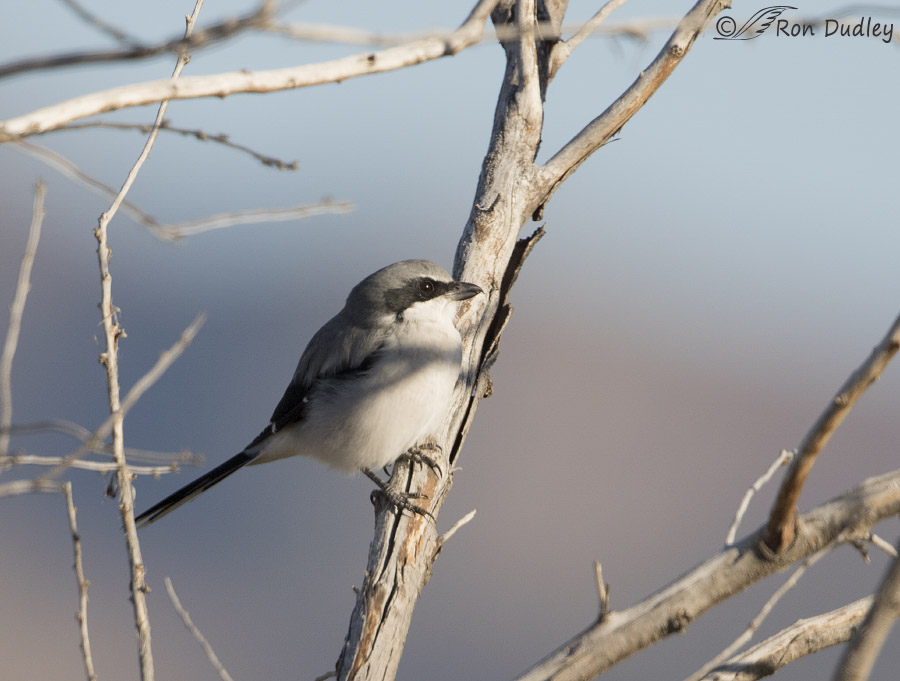
1/1600, f/6.3, ISO 400, Canon 7D Mark II, Canon EF500mm f/4L IS II USM +1.4 tc, not baited, set up or called in
I photographed the bird in the morning two days ago near Fairfield, Utah. At first it looked innocent enough as it perched in an old, dead thorny tree but it soon became obvious that it was there for a reason.
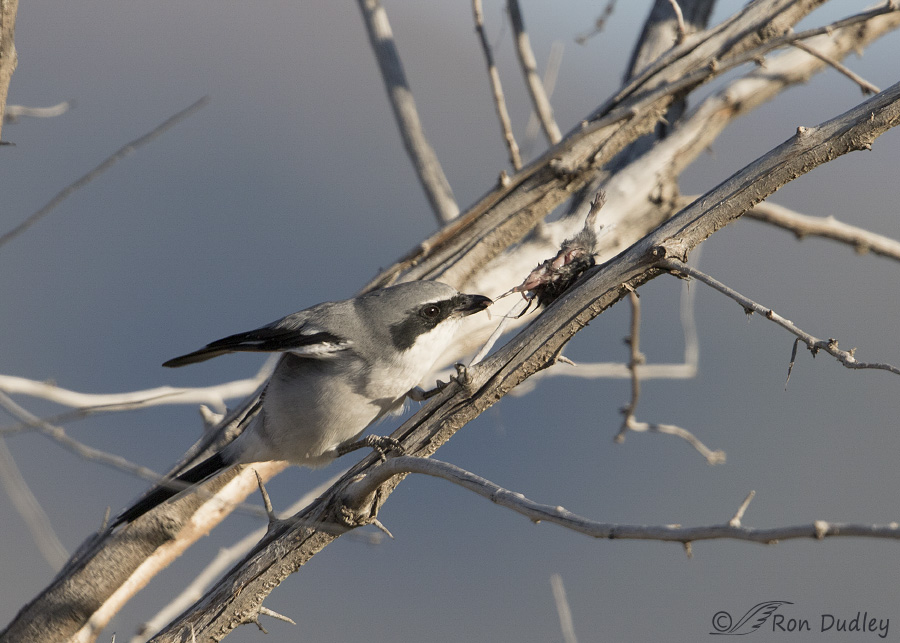
1/2000, f/6.3, ISO 500, Canon 7D Mark II, Canon EF500mm f/4L IS II USM +1.4 tc, not baited, set up or called in
Just a few feet away there was half of a vole carcass that the shrike had already impaled on a thorn and the bird quickly began to feed on it. Shrikes are “wannabe raptors” that often prey on small amphibians, reptiles mammals and birds. They lack the stronger feet and talons of true raptors which would enable them to tear their prey apart easily so they’ve adopted the alternative strategy of impaling prey on thorns and barbed wire so that they can pull against it – just as this bird is doing.
Look carefully and you can see one foot of the vole with five little toes sticking up.
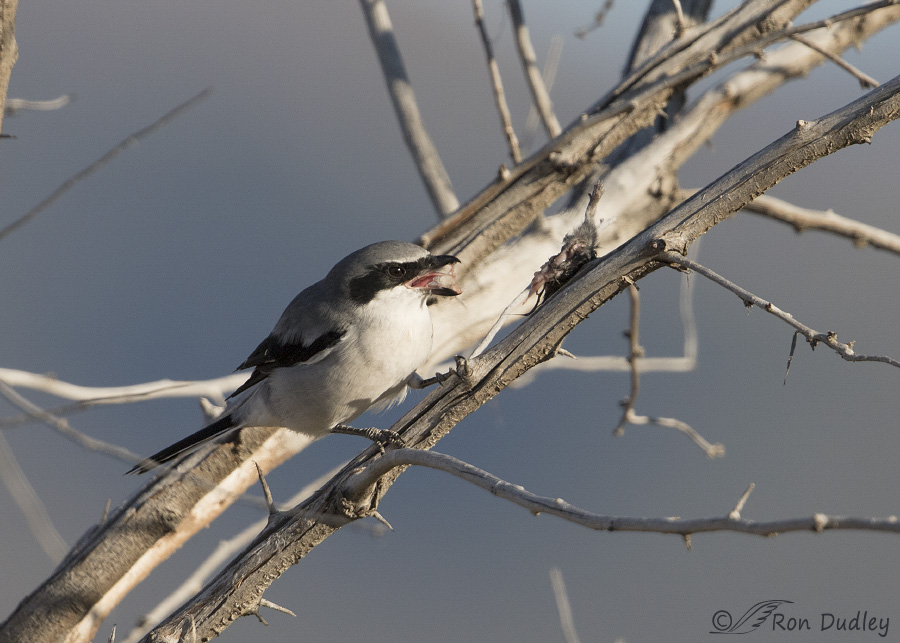
1/2000, f/6.3, ISO 500, Canon 7D Mark II, Canon EF500mm f/4L IS II USM +1.4 tc, not baited, set up or called in
Sometimes the shrike pulled off small pieces of meat and swallowed them but other times…
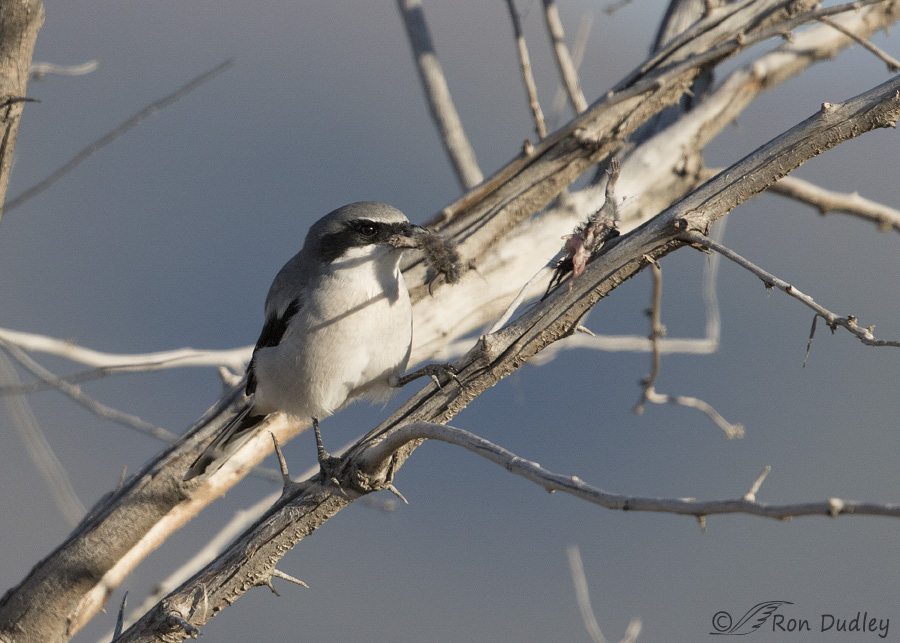
1/4000, f/6.3, ISO 800, Canon 7D Mark II, Canon EF500mm f/4L IS II USM +1.4 tc, not baited, set up or called in
it swallowed much larger pieces that consisted largely of hair and hide (and in this case, a foot).
At this point I managed to maneuver my pickup a little closer to the tree for a slightly better look at the proceedings.
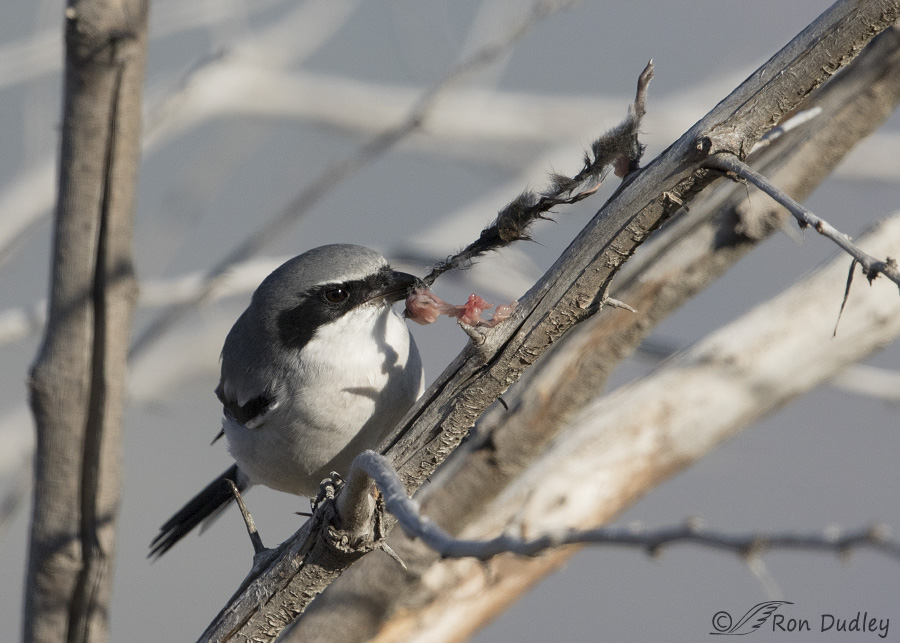
1/4000, f/6.3, ISO 800, Canon 7D Mark II, Canon EF500mm f/4L IS II USM +1.4 tc, not baited, set up or called in
The skin of the rodent was tough and the shrike sometimes really had to pull hard against the thorn to get a piece off.
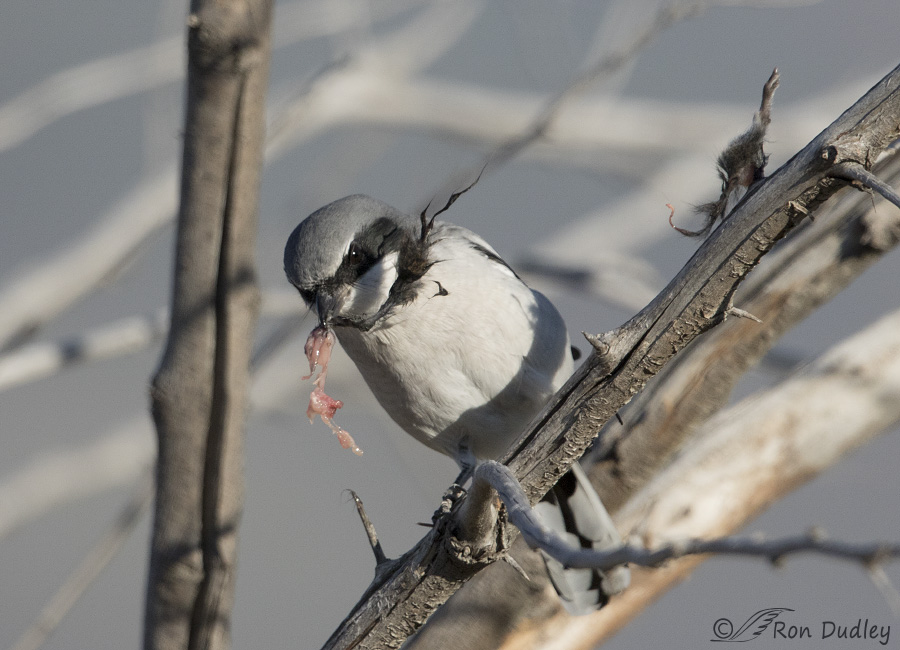
1/5000, f/6.3, ISO 800, Canon 7D Mark II, Canon EF500mm f/4L IS II USM +1.4 tc, not baited, set up or called in
When the piece of hair, hide and muscle was long and stringy…
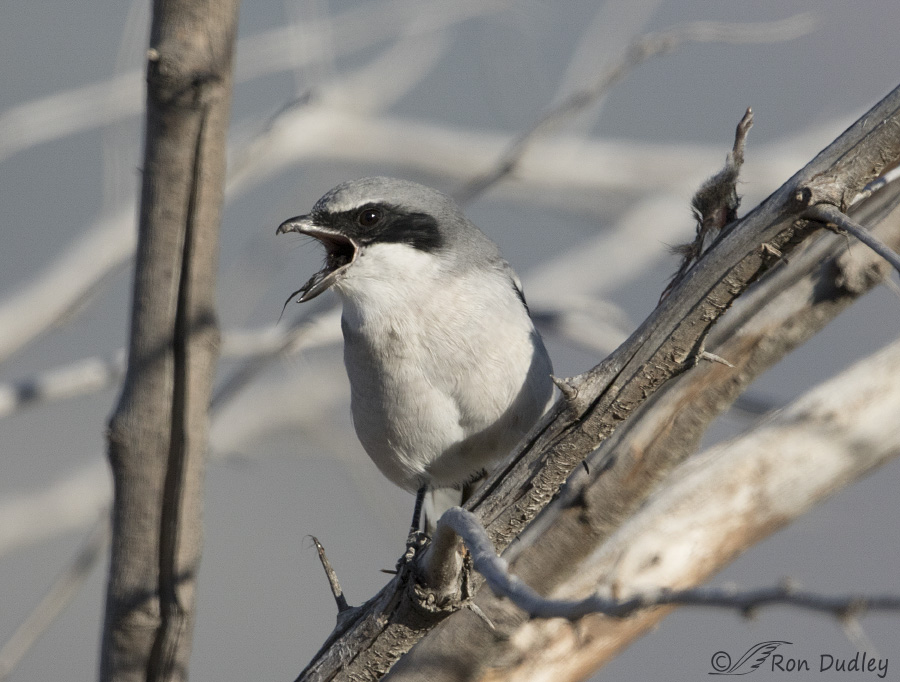
1/5000, f/6.3, ISO 800, Canon 7D Mark II, Canon EF500mm f/4L IS II USM +1.4 tc, not baited, set up or called in
it wasn’t easy to swallow but the shrike always managed to get it down.
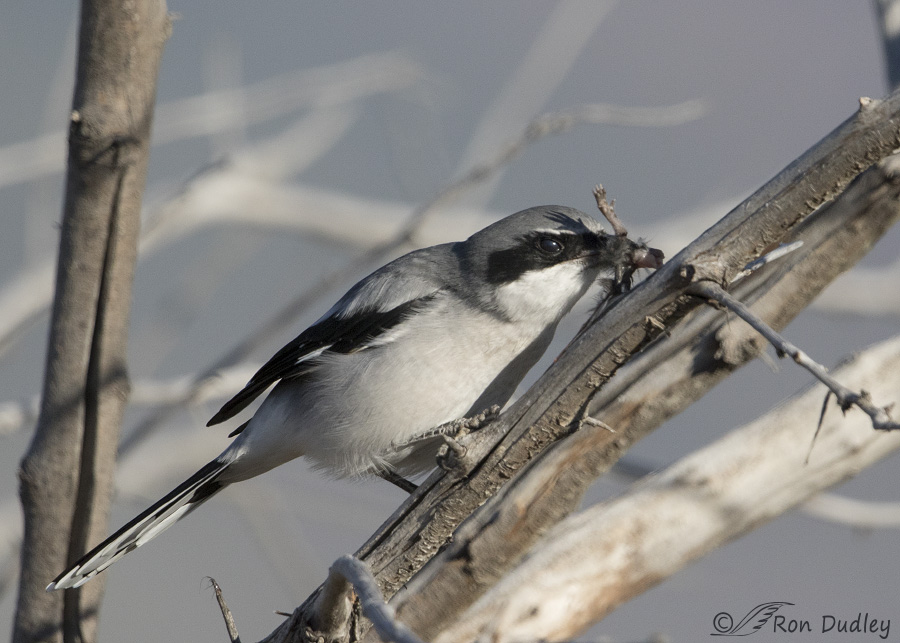
1/5000, f/6.3, ISO 800, Canon 7D Mark II, Canon EF500mm f/4L IS II USM +1.4 tc, not baited, set up or called in
When there was just a small bit of the vole left on the thorn the shrike initially couldn’t figure out how to get it off. It kept pulling but the hide of the vole was too tough and wouldn’t tear so the bird went in closer for an inspection (in this shot I like the shadow of the vole’s foot and toes on the forehead of the bird).
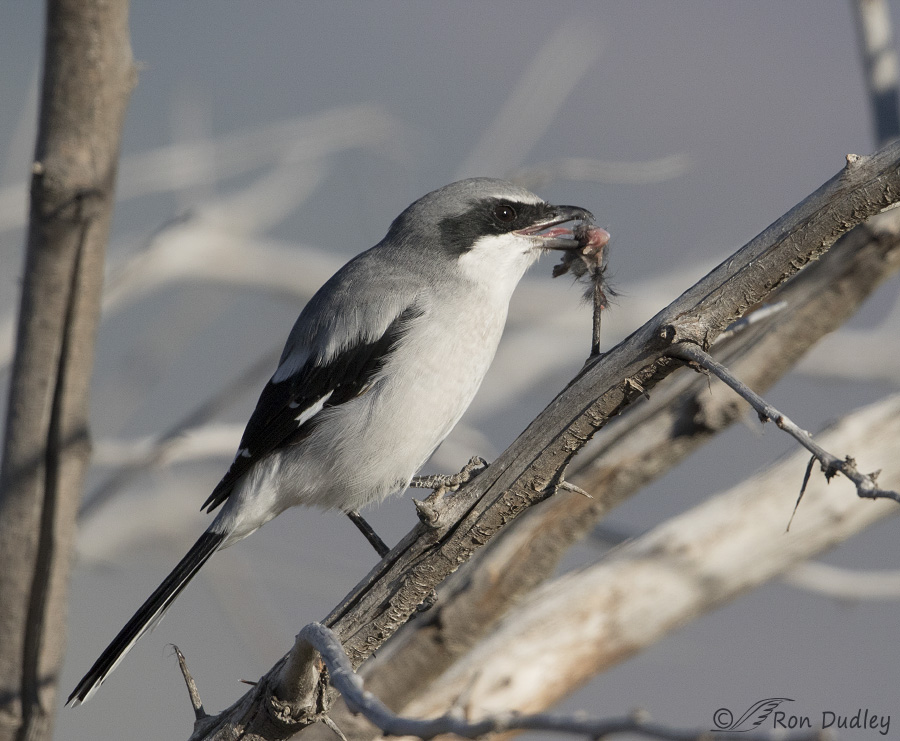
1/5000, f/6.3, ISO 800, Canon 7D Mark II, Canon EF500mm f/4L IS II USM +1.4 tc, not baited, set up or called in
But eventually the shrike figured out that if it lifted up on the carcass it would easily come off the thorn.
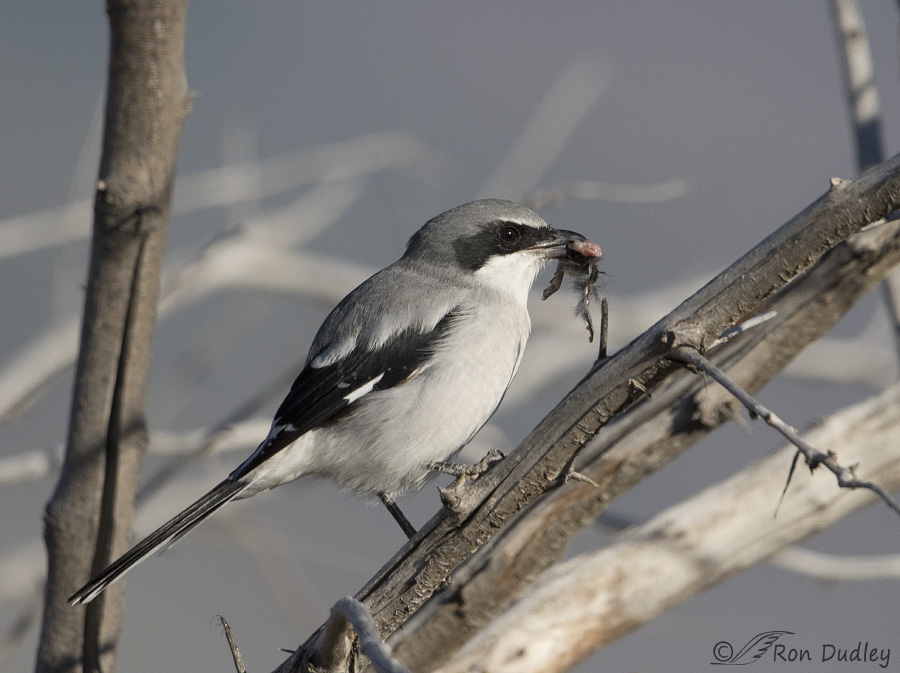
1/5000, f/6.3, ISO 800, Canon 7D Mark II, Canon EF500mm f/4L IS II USM +1.4 tc, not baited, set up or called in
And that’s exactly what happened. Here we get our best look at the thorn the vole was impaled on. The shrike then swallowed this last bit and flew off.
Obviously none of these images are aesthetically pleasing (for a variety of reasons…) but that’s often the case when my posts focus on behavior. I’m ok with that. In my view photos of interesting behaviors often trump the more common “beautiful pictures”.
Ron


Why do you call it “upper mandible” and not “maxilla” as we do in human anatomy? I recognize antiquated text books call the upper jaw the superior mandible and the inferior mandible as they arise from the same branchial arch. Is it a bird thing that does not carry over to birds. Great images as always. Thank you.
–Bridger
Hi Bridger,
Using that terminology with birds seems to be a convention followed by many authorities and I just join in. For example, this is from Birds of North America Online out of Cornell regarding the Loggerhead Shrike:
“Tomial tooth in upper mandible probably serves as a device for penetrating quickly to the spinal cord”
Absolutely incredible behavioral series, thanks for sharing Ron!
Charlotte
Thanks, Charlotte.
Love that they are not wasteful. At all.
Yet another area were we could usefully learn from the ‘bird-brained’.
I couldn’t agree more, EC.
Fascinating series. Clearly this is another bird who has a good brain and uses it. It’s wonderful to see the bird figure out the solution to its problem. I’m finally starting to see Loggerhead Shrikes at Hueco Tanks – saw my second one yesterday. Hopefully at some point I’ll get to observe some of their behavior.
I hope you get to see the impaling behavior, Susan. It’s fascinating.
This was very educational. thank you.
These are fantastic behavioral feeding series of the Loggerhead Shrike! You read it in books, never see the actual footage. I probably will never get to see this behavior except vicariously through your images! What a wonderful opportunity we all have to be witness to your photographic ability combined with your natural history instincts. The lessons from the Master, are enjoyed by us all, and I for one are very appreciative.
You give me too much credit, Dick but I appreciate your words very much. It’s just that I enjoy behaviors so much that I’m always looking for them and attempting to photograph them, often at the expense of more aesthetically pleasing images. I’m glad that you enjoy these behaviors too. Thank you.
Fantastic series, Ron! Of course, I also agree a good “behavior” image is more appealing than a “beauty portrait”. But, unlike you, maybe that’s mostly due to my not being able to master the latter. 🙂
“Butcherbirds” are fabulous opportunists and I never tire of watching them. Thank you for the regular doses of inspiration!
I was just reading this morning that you have a lot of shrikes in Florida, Wally. I’m glad you enjoy watching them – so do I.
I just love your posts and photos. I love photographing birds, especially those in motion, or engaging in their natural behaviors. Your photos give me something to aspire to!
Thanks very much, KE.
If a shrike’s impaled prey is just sitting there until it wants to feed again, don’t other critters take advantage of it, too? Like what? What happens then?
I imagine it happens, Patty but shrikes are pretty protective of their larder.
Most birds of prey either deliver a death bite to the spine just behind the head or suffocate their prey with pressure from their talons…right? Do Shrikes use the bite method? If not, what do they do? Glory questions, but I’m curious…
“Do Shrikes use the bite method?”
Yes, Patty, they do. They have a “tomial tooth” in their upper mandible that resembles the falcon tooth in falcons. They use it to disarticulate neck vertebrae and sever the spinal cord.
I love your behavior posts. It seems to me that when the vole was in one piece, it must have made a pretty large meal for such a small bird.
Thanks again, it was fascinating to see.
“it must have made a pretty large meal for such a small bird”
Sharon, This vole would have been several meals for the shrike. Impaling is also a means of food storage – they come back to it again and again.
It’s gruesome alright, but interesting, esp. since, as I understand it, the prey is dead when impaled…if not, I may toss my cookies…Here’s a gruesome question: Have you ever seen them actually impaling their cache?
“Have you ever seen them actually impaling their cache?”
Yes, I have, Patty – several times. Here’s a link to a post where I documented it. And within that post is a link to another one.
https://www.featheredphotography.com/blog/2012/12/30/loggerhead-shrike-attempting-to-impale-a-grasshopper/
Ron, this is an OUTSTANDING series of photos! I love the “wannabe raptor” description. And personally, I don’t find the photos gruesome at all. Instead, what I find gruesome is human food-handling practices. There is no honor or integrity in how we deal with our food, but that’s another discussion.
Thanks very much, Laura.
This was such an interesting series, Ron – and I just loved it!! Your comments for each photo were so informative. It also made me go to the Cornell Lab site because I couldn’t get a handle on the size of the Shrike. It looks no bigger than a sparrow so to learn from your blog and Cornell what a “wannabe raptor” it is blew me away. Wonderful lesson today, Ron!!
Yes, they’re quite small, Jo Ann, and fierce. I love’em but some folks have reservations about them because of their “lifestyle”. Thank you
The photo’s are interesting even if a bit gruesome. 🙂 We occasionally get one in the yard and boy, does it clear out the birds at the feeder in a hurry! Thx for the education and great pictures.
Yes, a bit gruesome, Judy, but then so can life be. I figured that my title would give fair warning about what to expect. I’m glad you enjoyed both the “education” and the photos. Thank you.